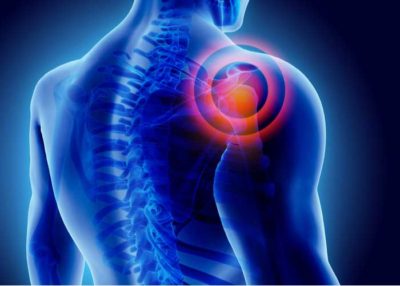Broken Shoulder Specialist

Do you play contact sports? If so, you may be at risk of sustaining a shoulder fracture. A shoulder fracture can be caused by a sudden force, impact or trauma to the joint during sports activities. A broken shoulder can also occur from a hard fall or accidnet. Broken shoulder specialists Doctor Riley J. Williams provides diagnosis as well as surgical and nonsurgical treatment options for patients in Manhattan, Brooklyn, New York City and surrounding areas who have sustained shoulder fracture. Contact Dr. Williams’ team today!
What is a shoulder fracture?
The shoulder is a ball and socket joint and consists of three bones: the humerus (upper arm bone) clavicle (collarbone) and scapula (shoulder blade). A fracture is a break in any one of the shoulder bones. Fractures occur in association with traumatic events like falls, car accidents or sports related impacts. There are two types of shoulder fractures: displaced and non-displaced. Displaced fractures may require surgery to reconstruct the affected bone and enable the return of normal function. The majority of shoulder fractures are non-displaced, which means the bones fragments are near their proper position; surgery is usually not necessary. Dr. Riley J. Williams, orthopedic shoulder specialist serving Manhattan, Brooklyn, New York City, NY and surrounding areas has extensive experience in treating shoulder fractures and shoulder related injuries.

What are the symptoms of a shoulder fracture?
Individuals in the New York area who have experienced trauma from a fall, a motor vehicle accident, a direct blow to the shoulder from sports may report the following symptoms in association with a shoulder fracture:
- Pain
- Swelling
- Bruising
- Limited mobility (if any)
- Grinding or clicking feeling
- Obvious deformity of the shoulder
How is a shoulder fracture diagnosed?
There are a few different types of breaks an individual may sustain in the shoulder. One type of fracture is a proximal humerus fracture. This type of break affects the ball portion of arm bone (humeral head). Elderly individuals are at risk for this type of break due to osteoporosis, which weakens bones. A fall on an outstretched hand can be cause for a proximal humerus fracture. A proximal humerus fracture can be simple or complex (comminuted). An x-ray can determine the type of proximal humerus fracture an individual has sustained. A scapula fracture is a break to the shoulder blade; this is an uncommon break due to its location at the upper rear thorax. A clavicle fracture is a common type of break of the collarbone. The clavicle connects the shoulder blade to the ribcage; the collarbone is at risk for fracture during a fall. Clavicle fractures occurs during many sporting activities such as football, soccer, cycling, downhill skiing, rugby and lacrosse. Dr. Williams will ask questions about the injury and perform a physical examination of the shoulder. An x-ray or musculoskeletal ultrasound will determine if there is a broken bone. Other imaging tests like a CT Scan or MRI may be necessary if other injuries were sustained with the break.
How is a shoulder fracture treated?
Non-surgical treatment:
Conservative treatment is typically reserved for non-displaced fractures. This means the bones have not shifted within the shoulder and are still aligned in an acceptable position. Bracing, sling wear, and immobilization can be recommended in cases of nondisplaced shoulder fractures. Dr. Williams may prescribe physical therapy during the healing process so that an individual can regain range of motion and shoulder function. Icing the injury and taking over-the-counter medication, such as ibuprofen or naproxen, can help with swelling and pain.
Surgical treatment:
Traumatic shoulder fractures and displaced fractures can require surgery. The goal of surgery is the proper positioning of a displaced fracture to an anatomic position. The surgical treatment necessary depends on the type of shoulder injury and type of fracture that was sustained. Fracture repair (open reduction and internal fixation) involves the use of plates and screws to facilitate proper bony healing; in the most severe cases of proximal humerus fractures, partial or total shoulder replacement surgery may be necessary. Dr. Williams will discuss the severity of the injury sustained and what surgical procedure are best for the patient to resolve the issue. Surgical treatment will also require physical therapy sessions after an individual has recovered from the procedure and the bone has begun to heal.
For more information on a shoulder fracture, including a proximal humerus fracture and a scapula fracture and the advanced treatment options available, please contact the office of Riley J. Williams, MD, orthopedic shoulder specialist serving Manhattan, Brooklyn, New York City, NY and surrounding areas.
